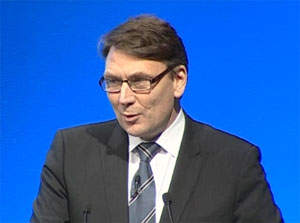Telstra profit drops 17% amid mobile adds

Telstra has reported a decline in net profit of 16.8 per cent year-on-year, down from $3.8 billion to $3.2 billion for the year to 30 June; however, the company has also added a total of 1.66 million new mobile customers in Australia.

Telstra CEO David Thodey (Screenshot by Josh Taylor/ZDNet Australia)
The addition of 742,000 new mobile customers in the second half of the financial year brought Telstra's total mobile customer base to 12.2 million. Postpaid handsets accounted for 645,000 of the new additions, giving the telco a total of 6.5 million postpaid customers.
A decline in prepaid mobile customers of 15,000 in the second half of the financial year is consistent with comments made by rival Vodafone at its results that customers are switching from prepaid to postpaid mobile plans.
Telstra's mobile broadband proved popular, with 914,000 new customers in the last financial year, bringing the total number of customers to 2.6 million. Telstra reported an increase in mobile revenue of 10.7 per cent, up $8.1 million from $7.3 million in the previous financial year.
Fixed-line revenue declined by 7.9 per cent to $5.3 billion. Telstra said that this was consistent with 2010 declines. Despite this, Telstra added 158,000 new fixed broadband customers, with 659,000 customers taking bundled products. Telstra sold a total of 175,000 T-Hubs and 190,000 T-Box devices during the financial year.
Telstra CEO David Thodey told analysts this morning that the company's strategy to pick up customers and improve customer service had begun to gain momentum.
"We think that we've really made some progress on it," he said. "Our price points are simpler, I think we are becoming easier to do business with — I didn't say easy — but easier to do business with."
Thodey said that the simplification strategy had helped keep customers and gain new ones in the process.
"When we survey our customers ... they are saying that things are improving and that's really gratifying," he said. "Numbers into the call centres have gone down. We think more of them are going online."
Despite this, Thodey noted that the number of customer complaints had not gone down, and more work needed to be done.
"A complaint is good, I see that as an opportunity to win the customer's heart in some way," he said.
In his final financial results briefing before his retirement at the end of the year, Telstra's chief financial officer Jon Stanhope noted that the company had increased operating expenses in the financial year by $970 million to $15.1 billion. He said that this was in line with the company's strategic initiatives for 2011 to improve customer service and acquire new customers.
In spite of recent market uncertainty, Thodey predicted that the positive momentum would continue, and the company forecast single-digit growth for financial year 2012. Thodey said that even if Telstra shareholders approve the $11 billion deal with the National Broadband Network Company (NBN Co) and the government on 18 October, which will see the migration of customers onto the NBN and the decommissioning of the telco's copper and hybrid fibre-coaxial networks, he didn't expect that payments from NBN Co would be significant in the 2012 financial year.
Stanhope said that the company plans to provide extra NBN information at future results reporting, and NBN revenue will be counted as "other revenue" instead of sales revenue.
Telstra has declared a fully franked final dividend of 14 cents, with a full-year payout of 28 cents, in line with 2010.